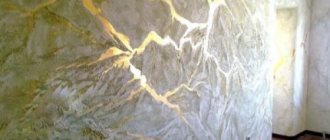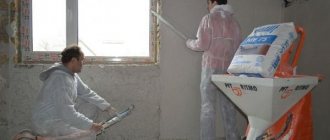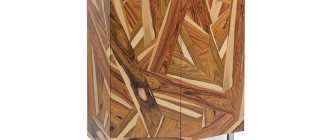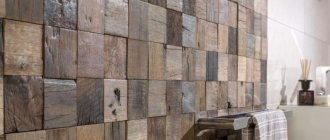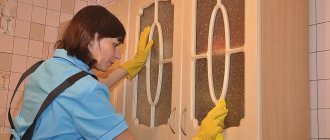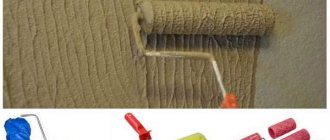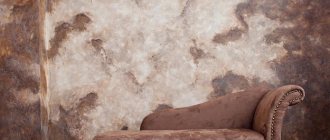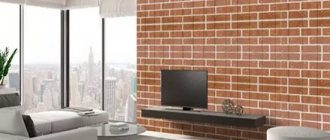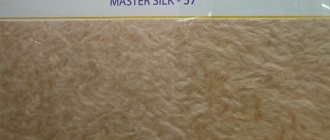Types of plaster: variety and purpose
Mosaic decorative mass, depending on the quality composition, as well as the nuances of use, is divided into several types:
- acrylic composition for covering the base of a building. The fine-grained base is visually close to a mosaic; it adheres well to traditional gypsum and cement plasters; such mosaics are coated with acrylic varnish for stability;
- facade plaster includes larger fractions and is applied in a thick layer, so small defects - cracks, unevenness - do not need to be leveled with additional mortar. The application technique speeds up the finishing work: the next layer of material is applied to the still wet previous one;
- fancy mosaic marble mixture designed for interior decoration. Here it is acceptable to use crumbs with different dispersion; there are no restrictions in the selection of shades.
The technologies used to make modern plaster imply the presence of granite, quartz, marble chips, plasticizers and other additives. Fine- and fine-grained options are suitable for interior finishing, while solutions with coarse inclusions are best chosen for exterior work.
How is mosaic material for wall decoration produced?
Decorative mosaic plaster is made from crushed granite and concrete fractions, therefore it exhibits excellent properties not only from a decorative point of view, but also from an operational point of view. Its advantages can be summarized as a list:
- • does not fade in the open sun under the influence of ultraviolet radiation, since it is not obtained by surface painting, and has the same structure;
- • exhibits incredible resistance to mechanical and impact impacts for plaster, which allows it to withstand a long service life;
- • not sensitive to moisture, as it has water-repellent properties, which makes it ideal for outdoor use;
- • has a high level of environmental friendliness and does not contain harmful impurities;
- • the coating requires a very thin layer, so the material has excellent air permeability, which will ensure optimal exchange between the room and the environment. This autumn is important for the prevention of fungal formations;
- • is quite easy to apply and has excellent adhesion to most surfaces, so you do not have to carry out additional manipulations to secure the finishing material in the chosen place.
Just one photo of mosaic plaster will be enough for the consumer to fall in love with this material and want it to decorate their own home.
Advantages of the original finishing material
Mosaic has always been loved by landscape designers and stylists. Its varieties decorate the facades of houses, gazebos in private areas, and add a special charm to the premises. This coating has undoubted advantages:
- polymers, without which modern plaster cannot be produced, guarantee the composition’s resistance to negative external influences: the walls are not afraid of increased dampness or contact with aggressive substances;
- plasticizers make it convenient to apply the substance to walls;
- The versatility of the coating was highly appreciated: it is suitable for decorating surfaces made of various base materials - brick, cement, plasterboard or other basic components;
- a huge selection of shades, the possibility of their combination will allow you to create original compositions. Mosaic finishing is in trend, because in this way it is easy to create real masterpieces;
- The environmental friendliness of the composition and its resistance to wet cleaning are important for lovers of comfort and safety.
Plaster with hard rocky inclusions has protective as well as decorative properties. The affordable price allows you to decorate any interior with fancy patterns or clear geometric shapes if desired.
What tools are needed?
Of course, applying mosaic plaster to the walls will be problematic if you do not buy the appropriate tools in advance:
- Spatula - We use this to apply plaster, so it must be made of appropriate materials. It is better to choose stainless steel products;
- Mixing unit - It must be equipped with a mixer because it uses it to mix the gypsum mass. Of course, we can also use wooden elements for this purpose, but they will not be as effective as a drill;
- Protective film - when applying plaster indoors;
- Ladder;
- Protective work clothing - don't risk staining your everyday clothes. Once the stains dry, they will be unsuitable for exterior repairs.
When it comes to the methods of applying plaster, they cannot be divided into categories. This is because we spread the mosaic plaster manually without using various devices. Because applying this type of plaster is extremely easy.
What is laminated veneer lumber? Manufacturing technology and application features
Is it worth buying a house with a plot in SNT for permanent residence (permanent residence)?
What is liquid wallpaper? And how are they better than paint, plaster and regular wallpaper?
Is it worth combining a living room and kitchen in a private house? What layout and design for a cottage is better to choose?
How to clean the surfaces of the walls of the house? Abrasive blocks
What will the development of the Near Moscow region with high-rise buildings and residential complexes lead to?
Interior decoration of a country house. What should you consider?
Why are cottages and houses with plots more expensive on individual housing construction lands?
Ecological renovation. What it is? What materials are harmful to health?
How to rent out your land plot and correctly draw up a land contract?
Surface preparation and nuances of mosaic application
The mosaic variation of plaster has become in demand due to its simple and quick installation method. The most popular are ready-made types with acrylic resin, supplemented with any stone chips. Natural crushed options and colored with available mineral dyes can be used as filler. Application of the composition implies the same procedure that is suitable for any mixture intended for leveling floors, partitions or decorating them.
Traditionally, like any other coating, the walls are leveled and primed. The plastic mass is comparable in thickness to cake dough. Before starting work, such a composition should be mixed and made sure that the color is uniform. The mosaic mixture is applied to the surface using a trowel and a trapezoidal trowel. Experts note that about 3 kg of composition will be needed to treat 1 m2.
If you are planning a strict interior with a uniform coating, then the plaster is applied in a thin but dense layer. The working plane must be filled from corner to corner; it is worth making sure that no joint strips remain. For complex combinations or to create fancy geometric patterns, marking the wall is necessary - this is done using simple pencils. It is wiser to seal the joints with nearby areas with masking tape. First, apply the base coat or fill the central part of the pattern. Allow the mixture to dry, and after 15-20 minutes remove the strips of tape and continue working.
Decorative finishing with an imitation mosaic pattern can become the starting point of any interior design and decorate the facade of the house. There are many ready-made mixtures, but many craftsmen prefer to prepare such compositions themselves. The technology of layer-by-layer application is elementary and does not require special skills.
Durability is the main advantage
Basement is the base of a building that rests on a foundation. In strip foundations, the base is the upper part of the foundation itself. Also, the plinth is the lower belt of the facade. The presence of a belt protects the building from environmental influences and pollution. To achieve the best result, you need to choose the right material for processing the base. Treating the base part of the foundation not only provides protective properties, but also gives the walls of the house an irresistible appearance. The choice of material for finishing the base is the best solution.
Related article: How to effectively eliminate parquet squeaks
Colored mosaic plaster
A durable layer of the mixture is applied to the base, while one rule is followed: the outer walls must be dry. This rule is due to the dense consistency of the mixture, through which water slowly evaporates. If this rule is violated, mold will form on the walls. Properly preparing the outside of the house for plastering is the key to the durability of mosaic plaster. The mixture, applied in a small amount to the wall of the building, turns out smooth and neat. Before starting the process, it is recommended to apply a layer of primer to the facade. The preparation process will help strengthen the base and regulate its ability to absorb moisture. Then the surface is leveled. Correctly completed preparation steps and the plastering process itself will allow you to achieve maximum stability of the exterior walls of the house.
Features of using mosaic plaster
The principle of using this material is similar to the use of conventional plaster mixtures.
Attention! All work related to plastering facades is carried out at an air temperature of no lower than +5 degrees, atmospheric humidity no more than 80 percent.
First, the surface is thoroughly cleaned of dust and dirt. Next, it needs to be sanded and leveled (if necessary). After the working surface has dried, begin applying the pre-prepared mass.
There are certain rules for performing such work that allow you to obtain the desired result. First, the plaster is applied to the wall to be decorated in strips of 80-100 mm, then it is smoothed out efficiently so that there are no gaps between the grains.
Advice! Try to apply mosaic plaster to the entire surface at once. In this case, the joints between its individual layers will not be noticeable.
There is no need to rub the mosaic mixture; this technology differs from the use of conventional plaster compositions.
If desired, you can apply the plaster by spraying, armed with a special device. To obtain a specific pattern or ornament, professionals first create part of the image from vertical slats, then fill the gaps in the pattern with multi-colored mosaic plaster. To give the facade visual volume, mixtures with different grain sizes are used.
Mosaic decorative plaster is a godsend for designers. If you show imagination and have professional skills, you can use it to create real architectural masterpieces on buildings. The video shows an example of how to use this material.
Advantages and disadvantages
Increasingly, mosaic plaster is being chosen for exterior decoration of the basement.
This is due to a large number of advantages of this material:
- ease of performing work on any basis;
- high resistance to natural phenomena;
- durability of use, the color of the material remains unchanged for a long time;
- high strength of the material;
- vapor permeability;
- no additional care required;
- elasticity of the solution;
- variety of colors of mixtures for plastering the base.
Combination of mosaic plaster on the plinth with bark beetle and lambskin
There are also disadvantages:
- if the finishing layer is damaged, it is difficult to restore without noticeable distortion;
- use of a special primer when performing work using mesh.
